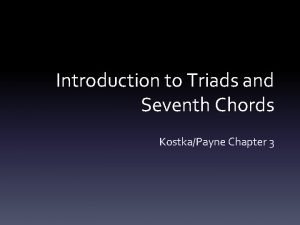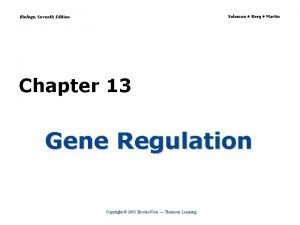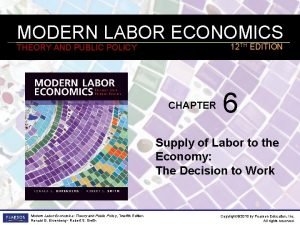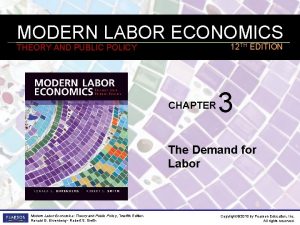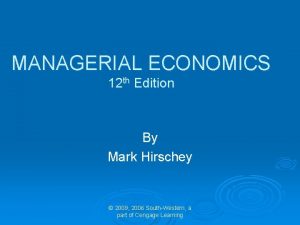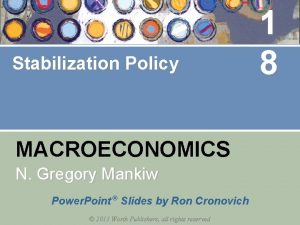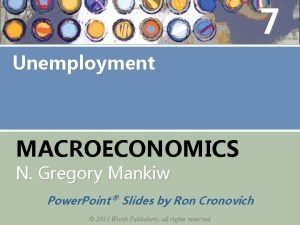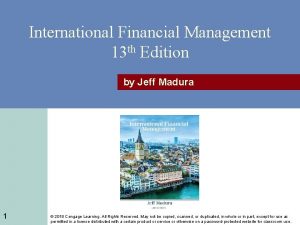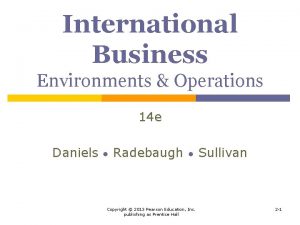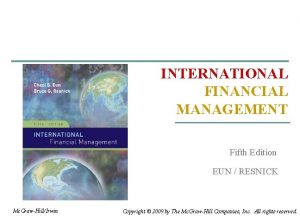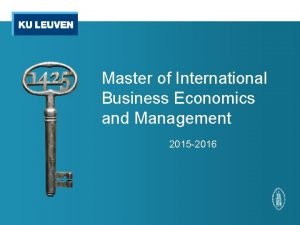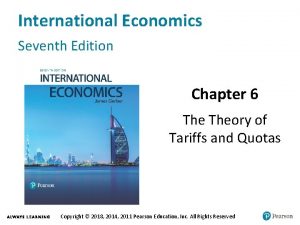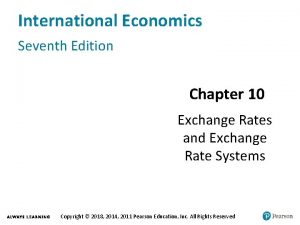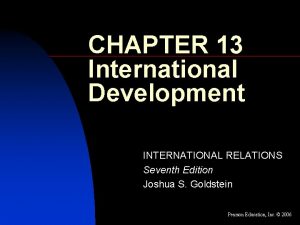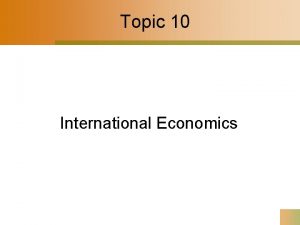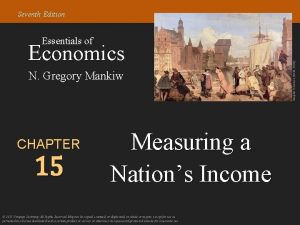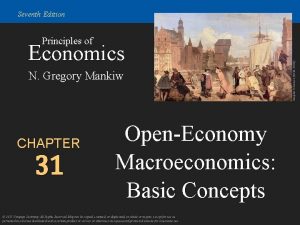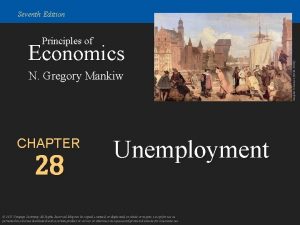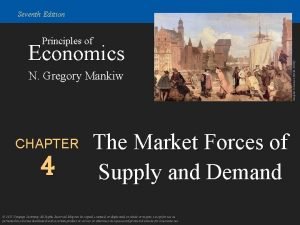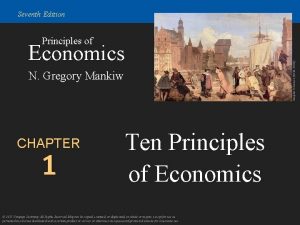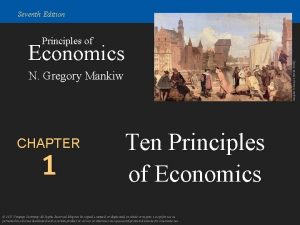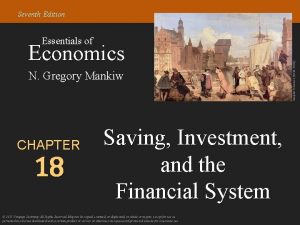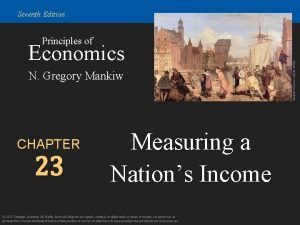International Economics Seventh Edition Chapter 11 An Introduction



































- Slides: 35

International Economics Seventh Edition Chapter 11 An Introduction to Open Economy Macroeconomics Copyright © 2018, 2014, 2011 Pearson Education, Inc. All Rights Reserved

Learning Objectives (1 of 2) 11. 1 Diagram a shift in aggregate demand or supply and explain the impact on the price level. 11. 2 Diagram the effects of GDP and the price level of expansionary and contractionary fiscal and monetary policies. 11. 3 Analyze the effects of fiscal and monetary policies on the current account and the exchange rate. Copyright © 2018, 2014, 2011 Pearson Education, Inc. All Rights Reserved

Learning Objectives (2 of 2) 11. 4 Explain how expenditure switching and expenditure reducing policies can be used to reduce a current account deficit. 11. 5 Draw a J-curve and use it to show exchange rate depreciation does not lead to an immediate reduction in the current account deficit. Copyright © 2018, 2014, 2011 Pearson Education, Inc. All Rights Reserved

Aggregate Demand Supply (1 of 9) • Since the Great Depression of the 1930 s, national governments have held a central role in guaranteeing economic growth, employment, and price stability. • In the aggregate demand supply model of this chapter, households, businesses, government and foreigners each play an important role. Copyright © 2018, 2014, 2011 Pearson Education, Inc. All Rights Reserved

Aggregate Demand Supply (2 of 9) Agent Function Households Supply land, labor, and capital to businesses Purchase consumer goods and services (C) Save Pay taxes (T) Businesses Use inputs supplied by households to produce nation’s output Purchase investment goods (I) Government Purchase government goods and services (G) Collect taxes (T) Foreigners Purchase exports (EX) and supply imports (IM) • There are four main agents in the macroeconomy, each with a different role and each a different source of demand for goods and services. Copyright © 2018, 2014, 2011 Pearson Education, Inc. All Rights Reserved

Aggregate Demand Supply (3 of 9) • Aggregate supply is the output of all final goods and services. – The AS curve shows the output businesses would produce at different price levels. • Aggregate demand is the sum of expenditures on final goods and services by households, businesses, government, and foreigners. – The AD curve shows the amount purchased at different price levels. Copyright © 2018, 2014, 2011 Pearson Education, Inc. All Rights Reserved

Aggregate Demand Supply (4 of 9) Copyright © 2018, 2014, 2011 Pearson Education, Inc. All Rights Reserved

Aggregate Demand Supply (5 of 9) As drawn, the AS curve has three regions: – A horizontal region representing levels of output below full employment; – An upward curving region representing an area nearer to full employment where inputs start to become scarcer and prices begin to rise with further increases in output. – A vertical region representing full employment. No further output is possible given the levels of labor, capital, and resources, and attempts to increase Q only cause a rise in P. Copyright © 2018, 2014, 2011 Pearson Education, Inc. All Rights Reserved

Aggregate Demand Supply (6 of 9) • In the short run and medium run, many fluctuations in the economy are attributable to shifts in aggregate demand. • When consumers, businesses, governments, or foreigners change their demands for goods and services, the AD curve will shift. Copyright © 2018, 2014, 2011 Pearson Education, Inc. All Rights Reserved

Aggregate Demand Supply (7 of 9) Copyright © 2018, 2014, 2011 Pearson Education, Inc. All Rights Reserved

Aggregate Demand Supply (8 of 9) • Figure 11. 2 shows an increase in AD, and rises in prices and output. • The steeper the AS curve, the more of the increase in AD that is channeled into price increases; the flatter, more it is channeled into output increases. • When output increases, incomes increase; we can be fairly certain that some amount of the new, higher level of income will be passed on as another round of increasing demand income. – This is called the multiplier effect. Copyright © 2018, 2014, 2011 Pearson Education, Inc. All Rights Reserved

Aggregate Demand Supply (9 of 9) • Economists disagree as to the size of the multiplier; in all likelihood it varies depending on a number of factors. – How close or far from full employment; – What part of the economy receives the initial increase in spending; – How the increase in spending is paid for; • Each new round of spending-income-spending, etc. , is decreased by the propensity of households to save part of an increase in income, and because part is spent on imports. – Hence, the multiplier effect eventually disappears. Copyright © 2018, 2014, 2011 Pearson Education, Inc. All Rights Reserved

Fiscal and Monetary Policies (1 of 4) • Fiscal policies are policies of taxation and government spending; – Expansionary fiscal policy refers to an increase in government spending and/or a cut in taxes. Both increase overall spending in the economy. – Contractionary fiscal policy, also called austerity, refers to a decrease in government spending and/or an increase in taxes. Both reduce overall spending in the economy. • Monetary policies are policies of interest rates and the money supply; – Expansionary monetary policy refers to a decrease in interest rates as a result of an increase in the money supply. – Contractionary monetary policy refers to an increase in interest rates as a result of a decrease in the money supply. Copyright © 2018, 2014, 2011 Pearson Education, Inc. All Rights Reserved

Fiscal and Monetary Policies (2 of 4) • Problems with fiscal policy: – Inflationary bias; – Multipliers are not well understood and the size is often estimated incorrectly; – Different methods of financing increases in government spending have different multipliers; – Cumbersome to implement, with long and uncertain lags. • For these reasons and others, fiscal policies were not widely used from the 1980 s on. • Nevertheless, when monetary policy fails, they may be the only tool left to manage a recession. Copyright © 2018, 2014, 2011 Pearson Education, Inc. All Rights Reserved

Fiscal and Monetary Policies (3 of 4) • Monetary policy is more agile than fiscal policy. – Relies on changes in the money supply that affect interest rates. – This is relatively easy to accomplish, compared to fiscal policy. • The central bank uses open market operations to alter the money supply. – Selling bonds shrinks the money supply and rises interest rates. – Buying them does the opposite. Copyright © 2018, 2014, 2011 Pearson Education, Inc. All Rights Reserved

Fiscal and Monetary Policies (4 of 4) Copyright © 2018, 2014, 2011 Pearson Education, Inc. All Rights Reserved

Case Study: Fiscal and Monetary Policy During the Great Depression (1 of 3) • The Great Depression was a worldwide depression; – It was actually two recessions, one from 1929 to 1933 and the second from 1937 -1938. – Recovery from the first was not complete when the second began, so the whole decade is labeled as the Great Depression. • In the U. S. , unemployment reached 25 percent and GDP fell by approximately 26 percent from 1929 to 1933. Copyright © 2018, 2014, 2011 Pearson Education, Inc. All Rights Reserved

Case Study: Fiscal and Monetary Policy During the Great Depression (2 of 3) • Governments did not view it as their responsibility to stabilize the economy; nor did they think they could. § They believed that increases in government spending would replace, not supplement, private spending. • Governments were afraid to raise government spending too much for fear of increasing the size of the budget deficit. – They believed that budget deficits undermined business confidence in government policy and would worsen the depression. – No one understood fiscal policy as a tool for fighting recessions. Copyright © 2018, 2014, 2011 Pearson Education, Inc. All Rights Reserved

Case Study: Fiscal and Monetary Policy During the Great Depression (3 of 3) • Governments were also obligated to maintain the gold standard. – They could not engage in expansionary monetary policy if it would lead to falling interest rates and gold outflows. • The UK left the gold standard in 1931 and began to recover. – The U. S. left the gold standard in 1933 when the new president, Franklin Roosevelt, took office. – Growth in 1934, 1935 and 1936 was rapid. Copyright © 2018, 2014, 2011 Pearson Education, Inc. All Rights Reserved

Current Account Balances Revisited (1 of 8) • How do fiscal and monetary policies affect the current account? • Two steps to describe this relationship: – First step: Monetary and fiscal policy impacts on interest rates and exchange rates. – Second step: Bringing in the current account. Copyright © 2018, 2014, 2011 Pearson Education, Inc. All Rights Reserved

Current Account Balances Revisited (2 of 8) • Recall the interest parity condition from Chapter 10: i – i* ≈ (F – R)/R. – If i rises, then foreign capital is attracted to the home country, the demand for its currency increases (supply of foreign exchange increases), and R will fall (an appreciation). – The effect of a fall in interest rates is symmetrical. Copyright © 2018, 2014, 2011 Pearson Education, Inc. All Rights Reserved

Current Account Balances Revisited (3 of 8) • Monetary policy works through interest rate changes. – Contractionary monetary policy will raise interest rates and, all else equal, cause an appreciation of the home country currency in a flexible exchange rate system. § This is why countries are often encouraged to raise interest rates if their currency is depreciating rapidly. – Expansionary policy has the opposite effect: interest rates fall, the currency depreciates. Copyright © 2018, 2014, 2011 Pearson Education, Inc. All Rights Reserved

Current Account Balances Revisited (4 of 8) • Fiscal policy effects on the exchange rate work through the change in income, and income’s effect on interest rates. – Expansionary fiscal policy raises incomes and spending. § The rise in income leads to an increase in the demand for money and an increase in interest rates if the money supply holds constant: The exchange rate appreciates. – The effects of contractionary fiscal policies are symmetrical. Copyright © 2018, 2014, 2011 Pearson Education, Inc. All Rights Reserved

Current Account Balances Revisited (5 of 8) • Exchange rate appreciation causes imports to be cheaper, and makes domestic goods more expensive to foreigners: – Imports increase, exports decrease, the current account moves in the direction of deficit. • Exchange rate depreciation causes imports to be more expensive, and makes domestic goods less expensive to foreigners: – Imports decrease, exports increase, the current account moves in the direction of surplus. Copyright © 2018, 2014, 2011 Pearson Education, Inc. All Rights Reserved

Current Account Balances Revisited (6 of 8) • Fiscal and monetary policies also have direct effects on the current account though their effects on income and spending. – Growth in spending at home increases imports, all else equal. • Fiscal policy’s direct effect on the current account: – The same as the effect via the interest rate and exchange rate channels. • Monetary policy’s direct effect on the current account: – Opposite of the effect via the interest rate and exchange rate channels. Copyright © 2018, 2014, 2011 Pearson Education, Inc. All Rights Reserved

Current Account Balances Revisited (7 of 8) Monetary Contraction Monetary Expansion Fiscal Contraction Fiscal Expansion Y and C Interest rates R CA or or • An increase in R is a depreciation. • Monetary and fiscal policies have different effects on interest rates, exchange rates and the current account. Copyright © 2018, 2014, 2011 Pearson Education, Inc. All Rights Reserved

Current Account Balances Revisited (8 of 8) • The long run: The economy tends to fluctuate around a full employment level of output. • Economists disagree as to how quickly an economy will return to full employment if it is recession, but all or nearly all agree that it will eventually get there. • Therefore, fiscal and monetary policies can alter the level of output and employment, but in the long run economies tend towards full employment. • Similarly, current accounts must eventually tend towards balance, although imbalances may persist for long periods of time. Copyright © 2018, 2014, 2011 Pearson Education, Inc. All Rights Reserved

Case Study: Argentina and the Limits to Macroeconomic Policy (1 of 3) • Argentina implemented a currency board in 1991 as a desperate attempt to control its monetary policy. – Previous governments resorted to excessive money creation to stimulate the economy and to provide revenue for the government. – The currency board was a part of new laws that: § Fixed the value of the Argentine peso to the dollar at a 1: 1 ratio; § Limited the creation of new money to the number of new dollars in reserve. Copyright © 2018, 2014, 2011 Pearson Education, Inc. All Rights Reserved

Case Study: Argentina and the Limits to Macroeconomic Policy (2 of 3) • When Argentina’s main trading partner, Brazil, devalued its currency in 1999, Argentina suddenly was at a disadvantage. – Brazilian demand for its goods shrank; – Argentina’s demand for Brazilian goods grew; – A large current account deficit opened while economic growth slowed dramatically. • Fiscal expansion was impossible due to the fear of its effect on prices and the deficit; • Monetary expansion was also impossible due to the effect it would have on the exchange rate. Copyright © 2018, 2014, 2011 Pearson Education, Inc. All Rights Reserved

Case Study: Argentina and the Limits to Macroeconomic Policy (3 of 3) • Argentina could have devalued its currency by leaving the 1: 1 peg to the dollar; – However, Argentina’s businesses and government had debt denominated in dollars that they incurred through the 1990 s when the economy was stable. • Argentines began taking large sums out of the banks, fearing a devaluation; • Argentina shut all banks in December, 2001; When the reopened in January, 2002, the link to the dollar was gone. • The peso fell in value, from 1: 1 to 1 peso per 0. 27 dollars; and a deep recession hit the country; growth eventually returned in 2003 after a nearly 20 percent loss in GDP, 1999 -2002. Copyright © 2018, 2014, 2011 Pearson Education, Inc. All Rights Reserved

Macro Policies for Current Account Imbalances (1 of 3) • Macroeconomic policies for addressing a current account imbalance: – Expenditure switching policies to shift spending from foreign to home goods and services. § Monetary and fiscal policies that cause a currency depreciation; § Temporary trade barriers to reduce imports. – Expenditure reducing policies to offset the increase in spending on domestic goods and services. § Contractionary monetary and fiscal policies to cut demand. Copyright © 2018, 2014, 2011 Pearson Education, Inc. All Rights Reserved

Macro Policies for Current Account Imbalances (2 of 3) • The adjustment process is the change in the current account balance that occurs in response to a change in the exchange rate. • Normally, the adjustment occurs with a lag. – The graph of the lag is called the J-curve. – Importers cannot switch to domestic suppliers immediately and foreign goods are suddenly more expensive. • U. S. experience shows that it can take 1 -2 years before the current account balance improves after a depreciation in the dollar. Copyright © 2018, 2014, 2011 Pearson Education, Inc. All Rights Reserved

Macro Policies for Current Account Imbalances (3 of 3) Copyright © 2018, 2014, 2011 Pearson Education, Inc. All Rights Reserved

Macroeconomic Policy Coordination in Developed Countries • Coordination of macroeconomic policies is a frequently sought goal, particularly when global growth is slow. – A simultaneous increase in fiscal or monetary expansion could avoid a disproportionate burden falling on one country. – If one country uses expansionary policies and the others do not, the expanding country is more likely to see a ballooning of its current account deficit. • There are several problems, however: – There is no international organization to arrange this. – It is rare that a large number of countries find it in their interests to pursue the same policies. Copyright © 2018, 2014, 2011 Pearson Education, Inc. All Rights Reserved

Copyright © 2018, 2014, 2011 Pearson Education, Inc. All Rights Reserved
 Figured bass seventh chords
Figured bass seventh chords 3 layers of muscle
3 layers of muscle Database system concepts seventh edition
Database system concepts seventh edition Principles of management information system
Principles of management information system Molecular biology of the cell seventh edition
Molecular biology of the cell seventh edition Biology seventh edition
Biology seventh edition Mis chapter 6
Mis chapter 6 Chapter 1
Chapter 1 Principle of management oxford fajar pdf
Principle of management oxford fajar pdf Modern labor economics 12th edition solution
Modern labor economics 12th edition solution Modern labor economics 12th edition pdf
Modern labor economics 12th edition pdf Microeconomics michael parkin 13th edition
Microeconomics michael parkin 13th edition Managerial economics hirschey
Managerial economics hirschey Markup economics
Markup economics Principles of economics mankiw 9th edition ppt
Principles of economics mankiw 9th edition ppt Principles of economics sixth edition
Principles of economics sixth edition Modern labor economics 12th edition
Modern labor economics 12th edition Principles of economics mankiw 9th edition ppt
Principles of economics mankiw 9th edition ppt Economics and business economics maastricht
Economics and business economics maastricht Elements of mathematical economics
Elements of mathematical economics International financial management 13th edition
International financial management 13th edition International financial management 5th edition
International financial management 5th edition International business daniels
International business daniels International human resource management dowling 6th edition
International human resource management dowling 6th edition International financial management 5th edition
International financial management 5th edition International financial management 13th edition
International financial management 13th edition International financial management 5th edition
International financial management 5th edition Ibfe manchester
Ibfe manchester Ku leuven international business economics and management
Ku leuven international business economics and management Ku leuven international business economics and management
Ku leuven international business economics and management аргентина средняя зарплата
аргентина средняя зарплата The devil from seventh grade 1960
The devil from seventh grade 1960 Who are the characters in the seventh man
Who are the characters in the seventh man You shall not steal. this commandment is number
You shall not steal. this commandment is number Heresy circle of hell
Heresy circle of hell Seventh-day adventist leadership structure
Seventh-day adventist leadership structure
